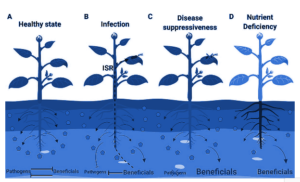
Courses

By Shailendra Singh
|
Updated on 8 May 2025, 14:58 IST
Growth is a fundamental feature of living organisms, and it involves a lasting change that makes a plant bigger. Similar to other living beings, plants also exhibit growth. It’s a vital characteristic for plants because it allows them to reach out for nutrients from locations far away from where they are rooted. Growth is the way plants compete with each other and safeguard their essential parts.
Seed germination is a noteworthy example of plant growth. In this process, a seed transforms into a seedling, and as it continues to grow, it eventually becomes a fully developed adult plant. This growth journey is crucial for the plant’s survival and success.
Phases of Plant Growth and Development – We all know that growth is an essential characteristic of all living organisms. It is an irreversible and endless metabolic process. Even plants have a unique ability to grow continuously throughout their life cycle. The whole process of growth and development in plants is taken out by the specialized cells called meristems. In this article, we will learn about the how plant growth happens, the different phases of plant growth, the conditions of growth, etc.
Plant growth happens in three stages – meristematic, elongation, and maturation. We can comprehend these phases of plant growth better by looking at a seed. We already know that the tips of roots and shoots exhibit steady growth and hence are meristematic.
The cells in this area are rich in protoplasm and have large nuclei. The cells next to this area represent the elongation growth phase. There is the construction of new cell walls, vacuoles, etc. The room next to the elongation phase represents the maturation phase in which the cells attain their maximal size.
Some of the components essential for the growth of plants are oxygen, water, and nutrients. Water penetrates the cells and causes turgidity. It results in the maturation of the cell. Water also supplies a medium for the activities of enzymes.
The metabolic energy needed for various activities is obtained from oxygen and sometimes nutrients. Optimum temperature, light, and gravity are also required for the proper maturing and development of the plant.
Let us look at the three phases of plant growth in detail below:
The cells in a plant’s root and shoot apex are constantly dividing. They represent the meristematic phase of growth. The cells in these areas have large nuclei and are rich in protoplasm, and their cell walls are thin and include cellulose.
The cells in the area just after the meristematic region represent the phase of elongation. The elements of cells in this zone are cell enlargement, increased vacuole formation, and new cell wall deposition.

Just close to the elongation phase, but away from the apex lies the maturation phase. The cells in this region reach their maximum size concerning their protoplasm and cell wall thickening.
Phases of plant development is the process where all the changes it goes through during its life cycle, from seed germination to senescence. The development of plants (i.e., development and differentiation) is affected by outside factors (light, temperature, water) and intrinsic factors (genes and plant growth controllers). Plants respond differently to the environment and phases of life and give rise to other structures.
This ability of plants is called ‘plasticity’. Example – The leaves of a young cotton plant differ from a mature cotton plant. Also, the leaves of the buttercup plant that grow in the air have a different shape than those that grow in water. This phenomenon of producing various forms is called ‘heterophylly’.

It’s a quantitative parameter and refers to an unrecoverable increase in the size or weight of a cell, towel, or organ. Plants can grow throughout their lives due to meristematic tissues present in the specific corridors.
Growth can be measured by increasing cell number, length, area, volume, and dry or wet weight.
The various stages of plant growth include
The critical factors affecting the growth of plants include
It is essential to study Phases of Plant Growth and Development unit because it makes us aware that plant growth relies on coordinating specific cell processes, cell division, cell expansion, and cell differentiation; the balance between these three cell processes determines optimal plant development. Plant growth is a continuous process starting with embryogenesis and the formation of the primary plant body (embryonic root and embryonic shoot) and continuing postgermination with the regular production of new organs (roots, leaves, branches, and flowers).
New cells are produced throughout a plant’s life within specialized zones, called meristems, containing self-renewing stem cells (SCs) which can become committed to a spectrum of developmental fates. During plant development, cells become specialized for a particular function, called cell differentiation. An interesting aspect of plants is that many differentiated plant cells can dedifferentiate and regenerate into whole plants under suitable conditions, a phenomenon called totipotency. The high degree of plasticity plants ultimately adapts their development to an ever-changing environment.
Elementary structures in plant development are buds, shoots, roots, leaves, and flowers; plants deliver these tissues and structures throughout their life from meristem located at the tips of organs or between mature tissues.
Meristems in the roots and shoots of plants are responsible for the ‘primary growth of the plant’. These increase the height of the plant.
Just close to the elongation phase, but away from the apex lies the maturation phase. The cells in this region reach their maximum size concerning their protoplasm and cell wall thickening.
Some of the components essential for the growth of plants are oxygen, water, and nutrients. Water penetrates the cells and causes turgidity. It results in the maturation of the cell. Water also supplies a medium for the activities of enzymes.